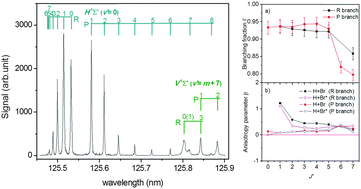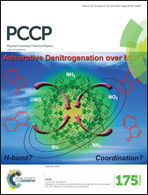Vacuum ultraviolet photodissociation of hydrogen bromide
Abstract
Photodissociation dynamics of HBr at a series of photolysis wavelengths in the range of 123.90–125.90 nm and at around 137.0 nm have been studied using the H atom Rydberg “tagging” time-of-flight technique. The branching fractions between the channels forming ground Br(2P3/2) and spin–orbit excited Br(2P1/2) atoms together with the angular distributions of the products corresponding to these two channels have been measured. The photolysis wavelengths in this work excited the HBr molecule from the ground state X 1Σ+ to various Rydberg states and the V 1Σ+ ion-pair valence state. Predissociation via these states displays rich behavior, indicating the influence of the nature of initially excited states and the coupling to other bound or repulsive states on the predissociation dynamics.


 Please wait while we load your content...
Please wait while we load your content...